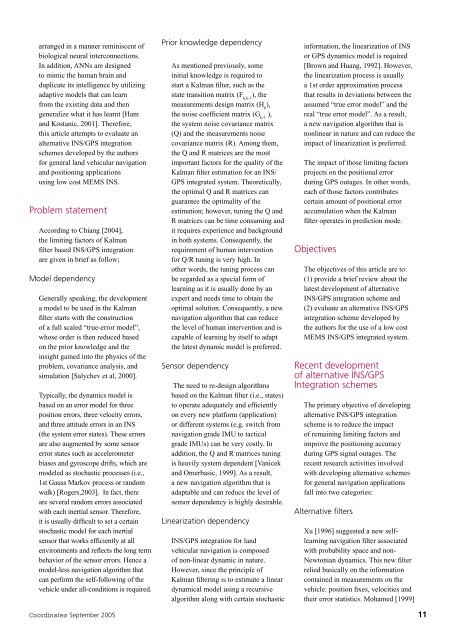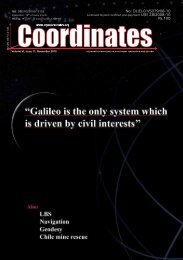MyGEOID dilemma - Coordinates
MyGEOID dilemma - Coordinates
MyGEOID dilemma - Coordinates
You also want an ePaper? Increase the reach of your titles
YUMPU automatically turns print PDFs into web optimized ePapers that Google loves.
arranged in a manner reminiscent of<br />
biological neural interconnections.<br />
In addition, ANNs are designed<br />
to mimic the human brain and<br />
duplicate its intelligence by utilizing<br />
adaptive models that can learn<br />
from the existing data and then<br />
generalize what it has learnt [Ham<br />
and Kostanic, 2001]. Therefore,<br />
this article attempts to evaluate an<br />
alternative INS/GPS integration<br />
schemes developed by the authors<br />
for general land vehicular navigation<br />
and positioning applications<br />
using low cost MEMS INS.<br />
Problem statement<br />
According to Chiang [2004],<br />
the limiting factors of Kalman<br />
fi lter based INS/GPS integration<br />
are given in brief as follow;<br />
Model dependency<br />
Generally speaking, the development<br />
a model to be used in the Kalman<br />
fi lter starts with the construction<br />
of a full scaled “true-error model”,<br />
whose order is then reduced based<br />
on the prior knowledge and the<br />
insight gained into the physics of the<br />
problem, covariance analysis, and<br />
simulation [Salychev et al, 2000].<br />
Typically, the dynamics model is<br />
based on an error model for three<br />
position errors, three velocity errors,<br />
and three attitude errors in an INS<br />
(the system error states). These errors<br />
are also augmented by some sensor<br />
error states such as accelerometer<br />
biases and gyroscope drifts, which are<br />
modeled as stochastic processes (i.e.,<br />
1st Gauss Markov process or random<br />
walk) [Rogers,2003]. In fact, there<br />
are several random errors associated<br />
with each inertial sensor. Therefore,<br />
it is usually diffi cult to set a certain<br />
stochastic model for each inertial<br />
sensor that works effi ciently at all<br />
environments and refl ects the long term<br />
behavior of the sensor errors. Hence a<br />
model-less navigation algorithm that<br />
can perform the self-following of the<br />
vehicle under all-conditions is required.<br />
Prior knowledge dependency<br />
As mentioned previously, some<br />
initial knowledge is required to<br />
start a Kalman fi lter, such as the<br />
state transition matrix (F k,k-1 ), the<br />
measurements design matrix (H k ),<br />
the noise coeffi cient matrix (G k-1 ),<br />
the system noise covariance matrix<br />
(Q) and the measurements noise<br />
covariance matrix (R). Among them,<br />
the Q and R matrices are the most<br />
important factors for the quality of the<br />
Kalman fi lter estimation for an INS/<br />
GPS integrated system. Theoretically,<br />
the optimal Q and R matrices can<br />
guarantee the optimality of the<br />
estimation; however, tuning the Q and<br />
R matrices can be time consuming and<br />
it requires experience and background<br />
in both systems. Consequently, the<br />
requirement of human intervention<br />
for Q/R tuning is very high. In<br />
other words, the tuning process can<br />
be regarded as a special form of<br />
learning as it is usually done by an<br />
expert and needs time to obtain the<br />
optimal solution. Consequently, a new<br />
navigation algorithm that can reduce<br />
the level of human intervention and is<br />
capable of learning by itself to adapt<br />
the latest dynamic model is preferred.<br />
Sensor dependency<br />
The need to re-design algorithms<br />
based on the Kalman fi lter (i.e., states)<br />
to operate adequately and effi ciently<br />
on every new platform (application)<br />
or different systems (e.g. switch from<br />
navigation grade IMU to tactical<br />
grade IMUs) can be very costly. In<br />
addition, the Q and R matrices tuning<br />
is heavily system dependent [Vanicek<br />
and Omerbasic, 1999]. As a result,<br />
a new navigation algorithm that is<br />
adaptable and can reduce the level of<br />
sensor dependency is highly desirable.<br />
Linearization dependency<br />
INS/GPS integration for land<br />
vehicular navigation is composed<br />
of non-linear dynamic in nature.<br />
However, since the principle of<br />
Kalman fi ltering is to estimate a linear<br />
dynamical model using a recursive<br />
algorithm along with certain stochastic<br />
information, the linearization of INS<br />
or GPS dynamics model is required<br />
[Brown and Huang, 1992]. However,<br />
the linearization process is usually<br />
a 1st order approximation process<br />
that results in deviations between the<br />
assumed “true error model” and the<br />
real “true error model”. As a result,<br />
a new navigation algorithm that is<br />
nonlinear in nature and can reduce the<br />
impact of linearization is preferred.<br />
The impact of those limiting factors<br />
projects on the positional error<br />
during GPS outages. In other words,<br />
each of those factors contributes<br />
certain amount of positional error<br />
accumulation when the Kalman<br />
fi lter operates in prediction mode.<br />
Objectives<br />
The objectives of this article are to:<br />
(1) provide a brief review about the<br />
latest development of alternative<br />
INS/GPS integration scheme and<br />
(2) evaluate an alternative INS/GPS<br />
integration scheme developed by<br />
the authors for the use of a low cost<br />
MEMS INS/GPS integrated system.<br />
Recent development<br />
of alternative INS/GPS<br />
Integration schemes<br />
The primary objective of developing<br />
alternative INS/GPS integration<br />
scheme is to reduce the impact<br />
of remaining limiting factors and<br />
improve the positioning accuracy<br />
during GPS signal outages. The<br />
recent research activities involved<br />
with developing alternative schemes<br />
for general navigation applications<br />
fall into two categories:<br />
Alternative fi lters<br />
Xu [1996] suggested a new selflearning<br />
navigation fi lter associated<br />
with probability space and non-<br />
Newtonian dynamics. This new fi lter<br />
relied basically on the information<br />
contained in measurements on the<br />
vehicle: position fi xes, velocities and<br />
their error statistics. Mohamed [1999]<br />
<strong>Coordinates</strong> September 2005 11

















